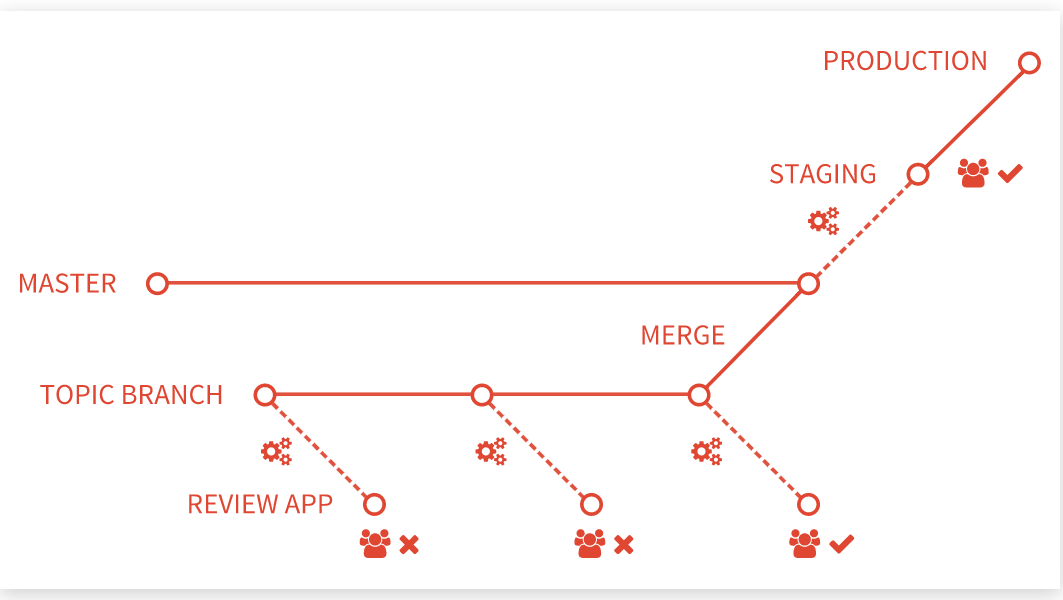The following page may contain information related to upcoming products, features and functionality. It is important to note that the information presented is for informational purposes only, so please do not rely on the information for purchasing or planning purposes. Just like with all projects, the items mentioned on the page are subject to change or delay, and the development, release, and timing of any products, features or functionality remain at the sole discretion of GitLab Inc.
| Stage | Verify |
| Maturity | Complete |
| Content Last Reviewed | 2024-01-24 |
Thanks for visiting this category direction page on Review Apps in GitLab. This page belongs to the Pipeline Execution group of the Verify stage and is maintained by Rutvik Shah (E-Mail).
This direction page is a work in progress, and everyone can contribute:
Review Apps let you build a review process right into your software development workflow by automatically provisioning test environments for your code, integrated right into your merge requests. Not only can you enable your teammates to easily participate in the review, but you also can also shift additional activities left, such as running DAST in your review apps.
Review Apps enable users to perform usability testing for any number of code changes, spanning the personas of product managers, release managers, designers, and software engineers in a single place. As an end to end application, we offer other features involving the designer in the DevOps lifecycle, including Design Management in the Create stage. Review Apps also ties into our progressive delivery vision of CI/CD as it gives you a glipse of how your application will look after a specific commit, way before it reaches production.
Our ultimate goal is that Review Apps should spin up with a one-click button that works automatically regardless of the deployment target (this includes cloud-native and mobile as well). Anyone can view, comment and even fix any errors found directly from the review app itself.

This area of the product is in need of continued refinement to add more kinds of Review Apps (such as for mobile devices), and a more robust and efficient experience, including configuration improvements and usability enhancements.
There are no new planned features in Review Apps for 2024. Pipeline Execution will support high priority bug fixes in this category as they arise. Please note: Visual Reviews is deprecated and will be removed in 17.0.
BIC (Best In Class) is an indicator of forecasted near-term market performance based on a combination of factors, including analyst views, market news, and feedback from the sales and product teams. It is critical that we understand where GitLab appears in the BIC landscape.
Customers utilizing microservice architectures find it challenging to manage the pre-production environments needed to validate changes before they are shipped. While Review apps are great for single services it can be difficult to support a microservice architecture like this or applicates in which multi project pipelines are utilized to deploy the service(s). Two issues designed to address some of these challenges with Review Apps are:
gitlab#235686 extends support for review apps from a child pipeline when using parent-child pipelines.
We see additional opportunities to improve the Review Apps user experience and enable faster code reviews.
The next set of features we are considering are captured in the Review Apps to Lovable epic.
One big advantage Heroku Review Apps have over ours is that they are easier to set up and get running. Ours require a bit more knowledge and reading of documentation to make this clear. We can make our Review Apps much easier (and thereby much more visible) by
implementing One button to enable review apps, auto-edit .gitlab-ci.yml, auto-configure GKE, which does the heavy lifting of getting them working for you.
Netlify Deploy Previews provide functionality similar to Review Apps and work with both GitLab and GitHub. Combined with their notifications capabilities this provides a compelling way to share a preview of changes with intersted stakeholders as they are happing. Netlify also provides the ability to let any user leave comments on these deploy previews as noted on the Usability Direction Page.
Vercel is a newer product with a suite of features focused on the web developer, including Previews. Their product is compatible with GitLab, GitHub, and BitBucket. Vercel recently launched commenting on previews, which is similar to our Visual Review Tool. We are evaluating the Previews as part setting our category direction.